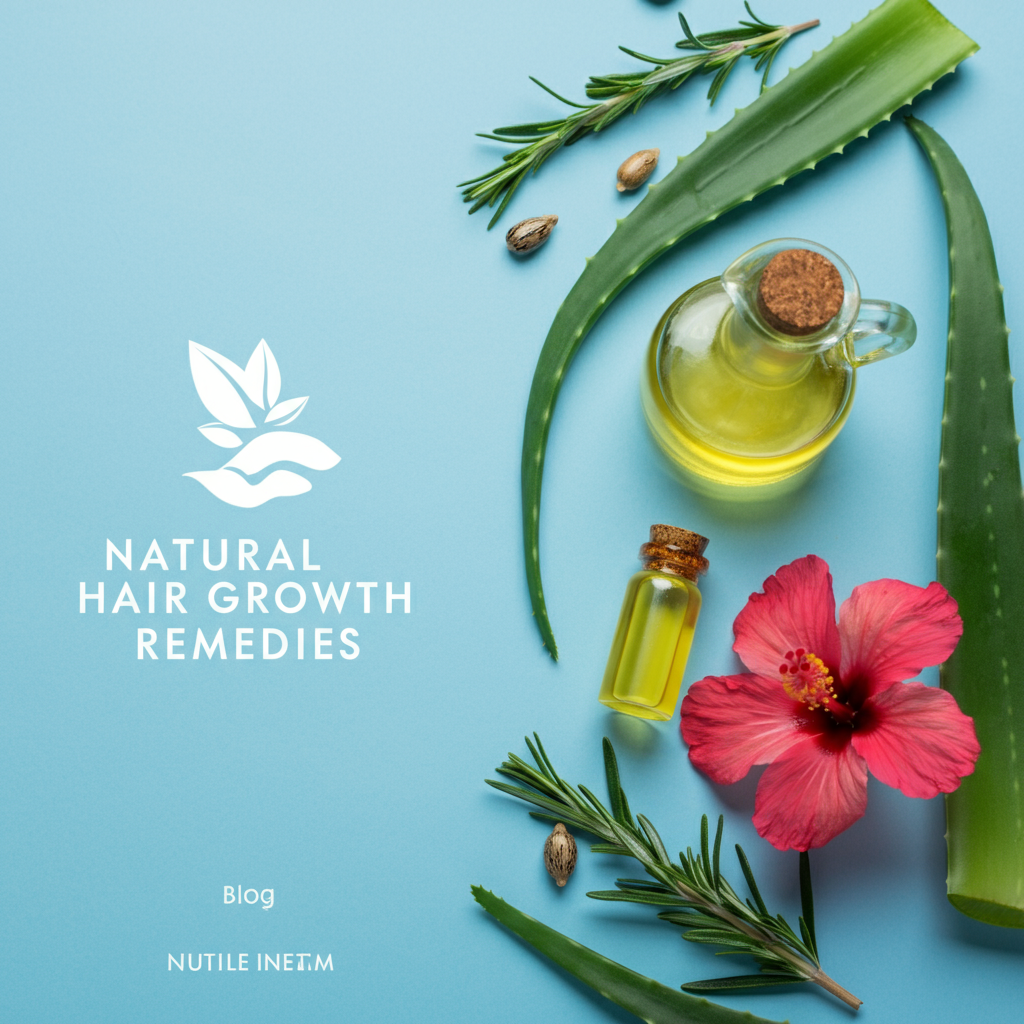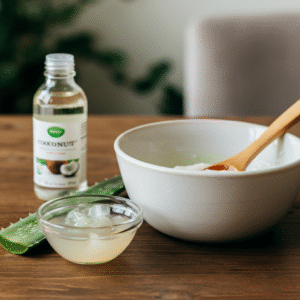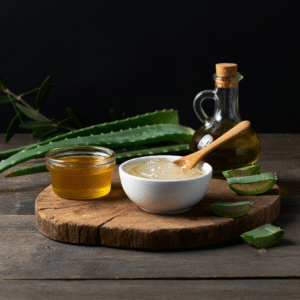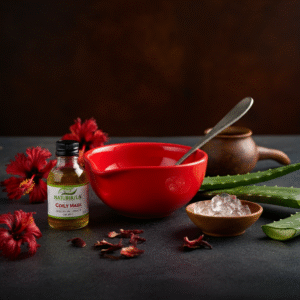
Introduction
Not every hair type thrives on the same oil or mask. A treatment that helps beautiful curls flourish might weigh down fine, straight hair. If you’ve ever felt disappointed by a one-size-fits-all approach to hair care, you’re not alone. The secret to unlocking your hair’s potential lies in personalization. Understanding your unique hair type is the first step toward finding the perfect natural remedies to encourage growth, strength, and shine.
This guide is your comprehensive resource for personalized, natural hair growth solutions. We will explore powerful home remedies for hair growth, including DIY hair masks, beneficial herbal hair growth treatments, and the best natural oils for your specific needs. Get ready to discover a customized routine that works in harmony with your hair, not against it.
Understanding the Basics of Hair Growth
Before diving into specific treatments, it’s helpful to understand how your hair grows and what can affect it. Hair growth is a dynamic, cyclical process happening deep within the scalp. Each hair follicle operates on its own timeline, cycling through three main phases.
- Anagen (Growth Phase): This is the active phase where your hair grows. Cells in the hair bulb divide rapidly, and the hair shaft gets longer. This phase can last anywhere from two to seven years, determining the maximum length your hair can reach.
- Catagen (Transition Phase): A short, transitional stage that lasts about two to three weeks. During this time, the hair follicle shrinks, and hair growth stops.
- Telogen (Resting Phase): The final stage, where the hair follicle is completely at rest. This phase lasts for about three months. At the end of this period, the old hair sheds, and a new hair begins to grow from the follicle, starting the anagen phase again.
On average, a person loses about 50 to 100 hairs per day as part of this natural cycle. However, several factors can disrupt this process and impact hair growth:
- Genetics: Your genes play a significant role in determining your hair’s thickness, length, and growth rate.
- Nutrition: A balanced diet rich in vitamins and minerals like iron, biotin, and protein is crucial for healthy hair follicles. Deficiencies can lead to thinning and hair loss.
- Scalp Health: The scalp is the foundation for healthy hair. Issues like dandruff, excess oil, inflammation, or poor blood circulation can hinder follicle function.
- Hair Type: Your hair’s unique texture and structure influence how it responds to treatments and how prone it is to breakage.
Natural ingredients can support this cycle in powerful ways. Many herbal hair growth treatments work by stimulating the hair follicles, improving blood circulation to the scalp, and providing essential nutrients. For example, a simple scalp massage with natural oils can increase blood flow, delivering more oxygen and nourishment to the roots and encouraging a healthy anagen phase.
First, Identify Your Hair Type
Applying the wrong products can do more harm than good. A heavy oil on fine hair can leave it looking limp and greasy, while a lightweight rinse may not provide enough moisture for coily hair. That’s why identifying your hair type is the critical first step in creating a successful natural hair care routine.
Hair is generally classified into four main types, with subcategories that define the specific pattern. Here is a quick guide to help you classify yours:
- Type 1: Straight Hair: This hair type has no natural curl. The strands can be fine and thin or coarse and thick. Straight hair tends to get oily faster than other types because the scalp’s natural oils (sebum) can travel down the hair shaft easily.
- Type 2: Wavy Hair: This type has a natural “S” shape. It falls somewhere between straight and curly. Wavy hair can range from loose, gentle waves (2A) to more defined, deep waves (2C). It can be prone to frizz.
- Type 3: Curly Hair: This hair type has defined, springy curls that form spirals or ringlets. The curls can be loose (3A) or tight and corkscrew-like (3C). Curly hair is often dry because the twists and turns of the hair shaft make it difficult for sebum to travel down to the ends.
- Type 4: Coily Hair: Also known as kinky hair, this type features tightly packed curls or zig-zag patterns. The strands can be very fine and fragile or coarse and wiry. Coily hair (ranging from 4A to 4C) is the most fragile and driest hair type, making it prone to breakage.
Your hair’s texture dictates how well it absorbs oils and retains moisture. Straight hair might need lightweight natural remedies for hair growth, while coily hair requires rich, sealing butters and oils to lock in hydration. Understanding this relationship is key to choosing the right DIY hair masks for growth and other treatments.
Natural Hair Growth Remedies by Hair Type
Once you know your hair type, you can tailor your approach. Here are specific home remedies for hair growth customized for straight, wavy, curly, and coily hair.
1. For Straight Hair (Type 1)
Goal: The primary objective for straight hair is to stimulate growth and add volume without weighing it down or making it appear greasy. Lightweight, clarifying, and stimulating ingredients are your best friends.

Effective Natural Remedies:
- Aloe Vera Gel Massage: Aloe vera is a fantastic natural remedy for straight hair. It’s lightweight, promotes growth, and helps control sebum production, keeping your scalp balanced. Its soothing properties also calm any scalp irritation.
- Rosemary Water Rinse: Rosemary is a powerhouse for hair growth. It enhances blood flow to the follicles, which can awaken dormant ones. A simple rosemary water rinse after shampooing can invigorate the scalp without leaving any residue.
- Green Tea Rinse: Green tea contains EGCG (epigallocatechin gallate), an antioxidant that may help reduce DHT, a hormone linked to hair loss. A cool green tea rinse can naturally thicken hair and reduce shedding.
DIY Mask for Straight Hair:
For a clarifying and stimulating treatment, mix 2 tablespoons of fresh aloe vera gel with 1 tablespoon of coconut water. Apply this lightweight mixture to your scalp and hair, leave it on for 30 minutes, and then rinse with cool water. This mask hydrates and cleanses without the heaviness of oils.
2. For Wavy Hair (Type 2)
Goal: For wavy hair, the focus is on enhancing growth and strengthening roots while maintaining the natural wave pattern and fighting frizz. Treatments should be moisturizing but not so heavy that they pull out your waves.

Effective Natural Remedies:
- Coconut Oil Scalp Massage: Coconut oil penetrates the hair shaft to strengthen it from within, reducing protein loss and frizz. A gentle scalp massage with warm coconut oil before washing is an excellent home remedy for hair growth and shine.
- Onion Juice Treatment: Don’t let the smell deter you! Onion juice is rich in sulfur, which is known to promote collagen production and support new hair growth. It’s a potent herbal hair growth treatment for adding density.
- Fenugreek (Methi) Paste: Fenugreek seeds are packed with protein and nicotinic acid, which are known to stimulate follicles, strengthen the hair shaft, and add a beautiful shine.
DIY Mask for Wavy Hair:
To create a growth-boosting mask, blend the juice of half an onion with 2 tablespoons of aloe vera gel and a few drops of coconut oil. The aloe vera helps soothe the scalp and masks some of the onion’s pungent aroma. Apply to the scalp, leave for 20-25 minutes, and then shampoo thoroughly.
3. For Curly Hair (Type 3)
Goal: Curly hair craves deep moisture and scalp stimulation to thrive. The goal is to nourish the scalp, prevent breakage along the delicate curl pattern, and boost elasticity for bouncy, healthy curls.

Effective Natural Remedies:
- Castor Oil and Olive Oil Blend: Castor oil is famous for its hair-thickening properties. Blending it with olive oil makes it easier to apply and adds extra nourishment. This combination boosts scalp circulation and deeply moisturizes curls.
- Amla (Indian Gooseberry) Oil: An Ayurvedic staple, amla oil is rich in Vitamin C and antioxidants. It strengthens hair roots, prevents premature graying, and significantly reduces breakage, which is a common concern for curly hair.
- Aloe Vera and Honey Mask: Honey is a natural humectant, meaning it draws moisture from the air into your hair. Combined with the hydrating properties of aloe vera, this duo provides intense hydration and improves hair elasticity.
DIY Mask for Curly Hair:
For a super-hydrating weekly treatment, mix 2 tablespoons of aloe vera gel, 1 tablespoon of raw honey, and 1 tablespoon of olive oil. Apply this rich mask from roots to ends, focusing on the scalp. Cover with a shower cap for 30 minutes to trap heat and help the ingredients penetrate, then rinse and style as usual.
4. For Coily Hair (Type 4)
Goal: The top priorities for coily hair are preventing breakage and locking in moisture to improve elasticity. Because coily hair is the most fragile type, gentle, rich, and protective remedies are essential.

Effective Natural Remedies:
- Shea Butter and Castor Oil Cream: Shea butter is an incredible sealant that locks moisture into the hair shaft. When whipped with castor oil, it creates a rich cream that encourages thickness, protects ends, and prevents breakage.
- Peppermint Essential Oil Massage: Peppermint oil creates a tingling sensation that signals increased blood flow to the scalp. Adding a few drops to a carrier oil (like jojoba or coconut) for a scalp massage can stimulate dormant follicles.
- Hibiscus Flower Paste: In Ayurvedic tradition, hibiscus is known as the “flower of hair care.” It’s believed to awaken dormant follicles, prevent hair fall, and condition the hair, leaving it soft and manageable.
DIY Mask for Coily Hair:
Create a stimulating and moisturizing mask by grinding a few hibiscus leaves and a flower (if available) into a paste. Mix it with 1 tablespoon of castor oil and 1 tablespoon of aloe vera gel. Apply this paste thoroughly to your scalp and hair. Let it sit for 30 minutes before rinsing. This herbal hair growth treatment provides deep conditioning and supports robust growth.
Scalp Care: The Foundation of Hair Growth
You can’t grow a healthy garden in poor soil, and you can’t grow healthy hair from an unhealthy scalp. Scalp care is the most crucial, yet often overlooked, aspect of any natural hair growth routine. A clean, nourished, and well-stimulated scalp provides the perfect environment for your hair follicles to function at their best.
Think of your scalp as the starting point. Product buildup, dead skin cells, excess oil, and poor circulation can all suffocate your hair follicles, leading to slower growth and even hair loss. Integrating scalp care into your weekly routine is non-negotiable.
Key Scalp Care Practices:
- Natural Scalp Scrubs: Just like your face, your scalp benefits from exfoliation. A gentle scalp scrub removes buildup and dead skin cells, allowing your follicles to breathe. You can easily make one at home by mixing brown sugar with coconut or olive oil. Gently massage the mixture onto your damp scalp in circular motions before shampooing. Do this once a week or bi-weekly.
- Weekly Scalp Massages: This simple practice is one of the most effective home remedies for hair growth. Massaging your scalp for just 5-10 minutes a day can significantly improve blood circulation. Better blood flow means more nutrients and oxygen are delivered to your hair follicles, which is essential for the anagen (growth) phase. You can perform a dry massage or use one of the natural oils for hair growth mentioned in this guide. Use your fingertips (not your nails) to apply firm but gentle pressure in small circular motions across your entire scalp.
By prioritizing scalp exfoliation and regular massages, you are creating a fertile ground for thick, healthy, and long hair.
Powerful Natural Ingredients to Boost Hair Growth
While tailoring remedies to your hair type is key, some ingredients are universally beneficial for promoting hair growth. Here’s a closer look at some of the most effective natural oils and herbs.
|
Ingredient |
Main Benefit |
Best For |
|---|---|---|
|
Rosemary Oil |
Stimulates follicles, improves circulation |
All types |
|
Castor Oil |
Thickens and strengthens hair shaft |
Curly/Coily |
|
Aloe Vera |
Soothes scalp, provides lightweight hydration |
Straight/Wavy |
|
Onion Juice |
Boosts collagen, promotes regrowth |
Wavy/Curly |
|
Coconut Oil |
Provides deep moisture, reduces protein loss |
Wavy/Curly |
|
Fenugreek Seeds |
Reduces hair fall, strengthens roots |
All types |
|
Hibiscus Flower |
Stimulates dormant follicles, conditions hair |
Coily hair |
|
Peppermint Oil |
Increases scalp circulation |
All types |
|
Amla Oil |
Strengthens roots, rich in Vitamin C |
Curly/Wavy |
These ingredients can be used on their own, mixed into DIY hair masks for growth, or blended to create custom hair oil treatments. For example, a powerful DIY hair oil could involve infusing a carrier oil like olive or coconut oil with dried rosemary, fenugreek seeds, and amla powder.
Understanding Hair Porosity for Better Results
Beyond hair type, porosity is another crucial factor. Porosity refers to your hair’s ability to absorb and retain moisture. It’s determined by the structure of your hair’s cuticle layer.
- Low Porosity: The cuticles are tightly packed. Hair resists moisture but holds it well once absorbed. It’s prone to product buildup.
- Medium Porosity: The cuticles are looser. Hair absorbs and retains moisture easily. This is considered the “normal” or balanced type.
- High Porosity: The cuticles are raised or have gaps. Hair absorbs moisture quickly but also loses it just as fast. It’s often dry and frizzy.
Knowing your porosity helps you choose the right natural oils for hair growth.
|
Porosity Type |
Natural Remedy Focus |
Recommended Ingredients |
|---|---|---|
|
Low Porosity |
Lightweight, easily absorbed oils |
Argan oil, Jojoba oil, Aloe vera, Green tea |
|
Medium Porosity |
Balanced, multipurpose treatments |
Coconut oil, Olive oil, Rosemary oil |
|
High Porosity |
Sealing butters and rich oils to lock in moisture |
Castor oil, Shea butter, Hibiscus, Amla oil |
For low porosity hair, heavy oils like castor oil can just sit on top of the hair, leading to a greasy feel. For high porosity hair, lightweight remedies might not be enough to prevent moisture loss. Matching your remedies to both your hair type and porosity will give you the best possible results.
A Sample Weekly Routine for Natural Hair Growth
Consistency is the key to seeing results with natural remedies. Here is a sample weekly hair care plan you can adapt to fit your schedule and hair needs.
- Monday: Scalp massage with a growth-stimulating oil (e.g., rosemary or peppermint oil diluted in a carrier oil). Focus on massaging for 5-10 minutes to boost circulation.
- Wednesday: Apply a DIY herbal mask tailored to your hair type. Leave it on for at least 30 minutes before washing.
- Friday: Use a clarifying rinse after shampooing, such as a rosemary or green tea water rinse, to remove buildup and stimulate the scalp.
- Sunday: Dedicate this day to deep conditioning and scalp care. Start with a gentle scalp exfoliation, followed by a deep-conditioning treatment or hot oil treatment.
This hair growth routine ensures you are regularly nourishing your scalp, strengthening your strands, and clearing away any buildup that could hinder growth.
Common Mistakes to Avoid on Your Hair Growth Journey
As you explore these home remedies for hair growth, be mindful of common pitfalls that can set you back.
- Using Heavy Oils on Fine or Low Porosity Hair: As mentioned, shea butter and castor oil can be too heavy for some hair types, leading to greasy, weighed-down strands. Stick to lightweight options like aloe, argan oil, or jojoba oil.
- Overusing Potent Ingredients: While effective, some ingredients can be irritating if overused. Onion juice, for example, can cause scalp sensitivity if applied too frequently or left on for too long. Always patch-test new ingredients and listen to your scalp.
- Skipping a Thorough Cleanse: Oil treatments are fantastic, but failing to wash them out properly can clog follicles and negate the benefits. Use a gentle but effective shampoo to cleanse your scalp after any oil-based mask or massage.
- Ignoring Diet and Hydration: Topical treatments are only one piece of the puzzle. A balanced diet rich in protein, iron, and vitamins, along with drinking plenty of water, is fundamental for healthy hair growth from the inside out.
- Impatience: Natural remedies for hair growth take time. Hair grows about half an inch per month on average. Be patient and consistent with your routine for at least three to six months to see noticeable changes.
Conclusion
The journey to healthier, longer hair begins with understanding your unique needs. By identifying your hair type and porosity, you can move beyond generic advice and create a personalized routine of natural remedies for hair growth that truly works for you. From stimulating rosemary rinses for straight hair to moisturizing shea butter creams for coily hair, nature offers a rich pharmacy of ingredients to support your goals.
Remember that patience and consistency are your greatest allies. Embrace the ritual of caring for your scalp, nourishing your strands with DIY hair masks, and being mindful of your overall health. Your hair will thank you for it.
Ready to put this knowledge into practice? Start by identifying your hair type and trying one of the recommended DIY masks this week.
Frequently Asked Questions (FAQs)
Which natural remedy works fastest for hair growth?
There is no single “fastest” remedy, as results depend on individual factors like genetics, diet, and hair type. However, ingredients that stimulate scalp circulation, like rosemary oil and peppermint oil, are often reported to show results more quickly. Consistency is more important than any single ingredient.
Can these remedies replace professional treatments for hair loss?
These home remedies are excellent for supporting general hair health and encouraging growth. However, if you are experiencing significant or sudden hair loss, it is essential to consult a dermatologist or trichologist to rule out underlying medical conditions.
How often should I apply these DIY hair masks?
For most hair types, using a DIY hair mask once a week is a great starting point. If your hair is extremely dry or damaged, you might benefit from twice-weekly treatments. Oily hair types may prefer a mask every two weeks.
Can I mix multiple oils for a hair treatment?
Absolutely! Creating your own oil blends is a great way to get multiple benefits. A popular combination is mixing a nourishing carrier oil (like coconut or olive) with a stimulating essential oil (like rosemary or peppermint) and a sealing oil (like castor oil).





Leave a Reply